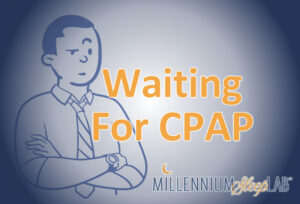If you have been diagnosed with obstructive sleep apnea (OSA) and your physician ordered a CPAP (continuous positive airway pressure), you may have to wait weeks or months for a CPAP because of a national shortage and backlog.
The delayed treatment is preventing you from feeling better and more rested, and you are still at risk of other medical conditions such as high blood pressure, diabetes, Afib. There are some actions you can take while you wait, and there are options other than CPAP.

Is Positive Airway Pressure worth waiting for?
Positive Airway Pressure (PAP) machines are the most effective treatment of sleep apnea, especially for moderate and severe apnea. It is endorsed by the American Academy of Sleep Medicine as first line treatment and is covered by almost all insurance.
Often called CPAP or Auto-CPAP, the machine is connected to a mask, worn snugly over the nose or nose and mouth, during sleep. Pressurized air flows into the sleeper’s throat, and the increased air pressure prevents the sleeper’s airway from collapsing.
While waiting, here are 3 suggestions for minimizing sleep apnea that you can start now:
Minimize Sleep Apnea with Positioning
Positional Therapy can help reduces snoring or sleep apnea for some people especially if events are primarily when sleeping on their back. They can eliminate or reduce airway blockage simply by learning to sleep on their side. Positional therapy generally works only in mild cases of OSA, but in more severe cases, it can still decrease the frequency and duration of apnea events.
When you do receive your CPAP, you can continue using the positioning pillow with CPAP, and you may be able to use a lower pressure setting on the blower. Contact Millennium Sleep Lab and ask about the “Slumber Bump”.
Minimizing Sleep Apnea with Weight Loss
The best indicator of sleep apnea is obesity, which means there is strong direct correlation between OSA and weight. Conversely, loosing weight can reduce sleep apnea. Exercise is difficult when experiencing the fatigue of sleep apnea, but starting a nutritional program and gradually adding physical activity can lead to weight loss and reduced apnea. Then when you begin CPAP, the increased energy and balanced hormone levels from treatment can help you continue your weight loss.
Minimizing Sleep Apnea by Limiting Alcohol
While many Americans enjoy a glass of wine with dinner or night cap to wind down before bedtime, the reality is that consuming alcohol worsens sleep apnea and does not improve sleep. Alcohol and other sedatives (barbiturates) depress the central nervous system and relax the body. With relaxed muscles including airway muscles, alcohol has been shown to worsen or even cause obstructive sleep apnea (OSA). While alcohol may help in initially falling asleep, it can cause disruptions the second half the night further contributing to poor, unrestful sleep.
If you want immediate treatment, here are 3 alternative OSA treatments to consider:
A Popular Alternative: Oral Appliance
Sleep apnea and snoring can also be treated with a dental appliance that opens the airway by bringing the lower jaw slightly forward. The appliance is worn in the mouth during sleep and resembles a mouth guard that an athlete might wear.
You can simulate the effect of an oral appliance with a simple experiment. If you make a snoring sound right now and, in the middle of it, push your jaw forward, you will see that the snoring sound stops.
Studies have shown Oral appliances are effective in eliminating sleep apnea in many patients, and the American Academy of Sleep Medicine has endorsed oral appliance therapy for patients with mild or moderate sleep apnea.
Many dentists offer Oral Appliance Therapy, and there is even one network of dentists specializing in sleep medicine that is able to bill most medical insurance in-network. Contact Sleep Impressions to see if they have one near you.
Airway Surgery is another Common Treatment
Depending on the location of the obstruction in the airway, a surgical procedure can be effective in treating obstructive sleep apnea, and it is often effective in treating snoring.
An ENT will try to determine what part of the upper airway is causing the obstruction to airflow. There are several possible sites, so there are many types of surgical procedures currently used to treat sleep apnea, including tonsilectomy, tongue base reduction, and uvulopalatopharyngoplasty (UPPP). The most common is UPPP, which has a success rate over 50 percent, and some surgeons have achieved very high success rates using multiple, staged procedures.
Airway Stimulation is an Effective Option
Airways stimulation therapy works inside your body while you sleep to treat the root cause of sleep apnea and keep your airway open. Inspire Medical Systems has designed a small device placed during an outpatient procedure. Use the remote at bedtime to turn on Inspire, and your airway is opened by slightly stimulating the muscles in your airway, allowing you to breathe normally and sleep peacefully. Inspire has been FDA approved to treat OSA since 2014. Learn more at https://www.inspiresleep.com/#how-it-works
If you have been diagnosed with sleep apnea but can’t get a CPAP, you can still take steps toward addressing your sleep apnea or find another treatment option altogether. But the longer you wait to take action, the more likely you are to develop health issues! Millennium Sleep Lab has physicians available via telemedicine to discuss your results and treatment options, just contact us to schedule.
